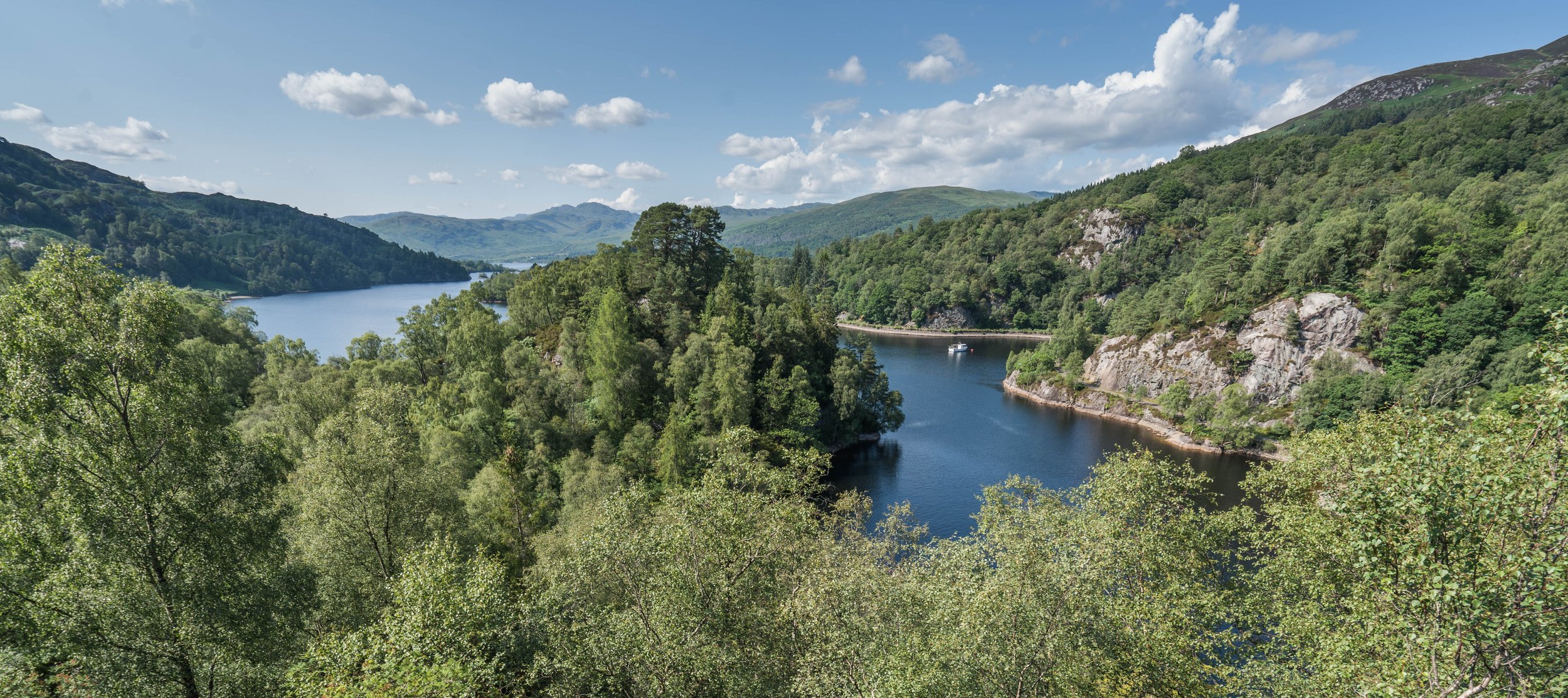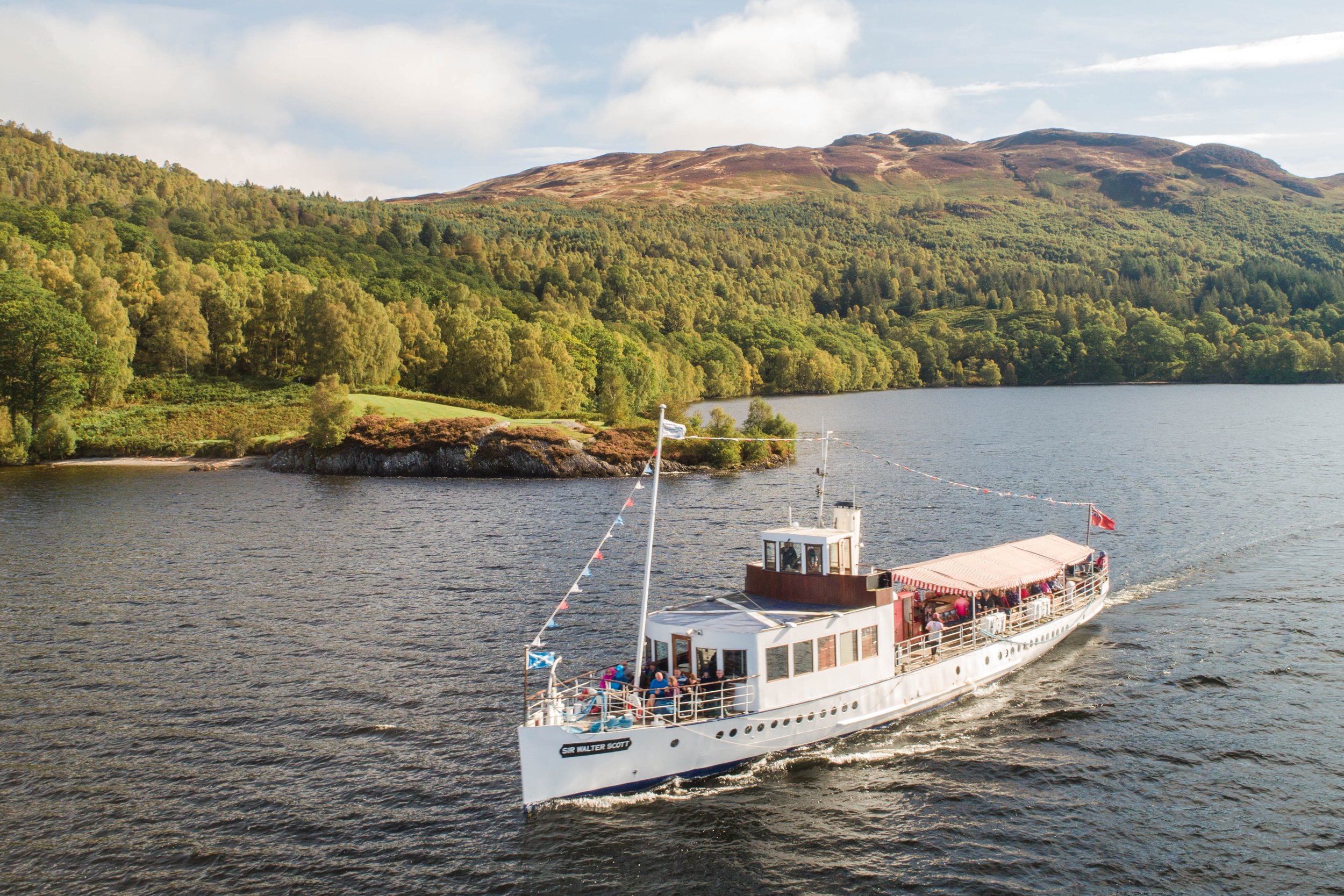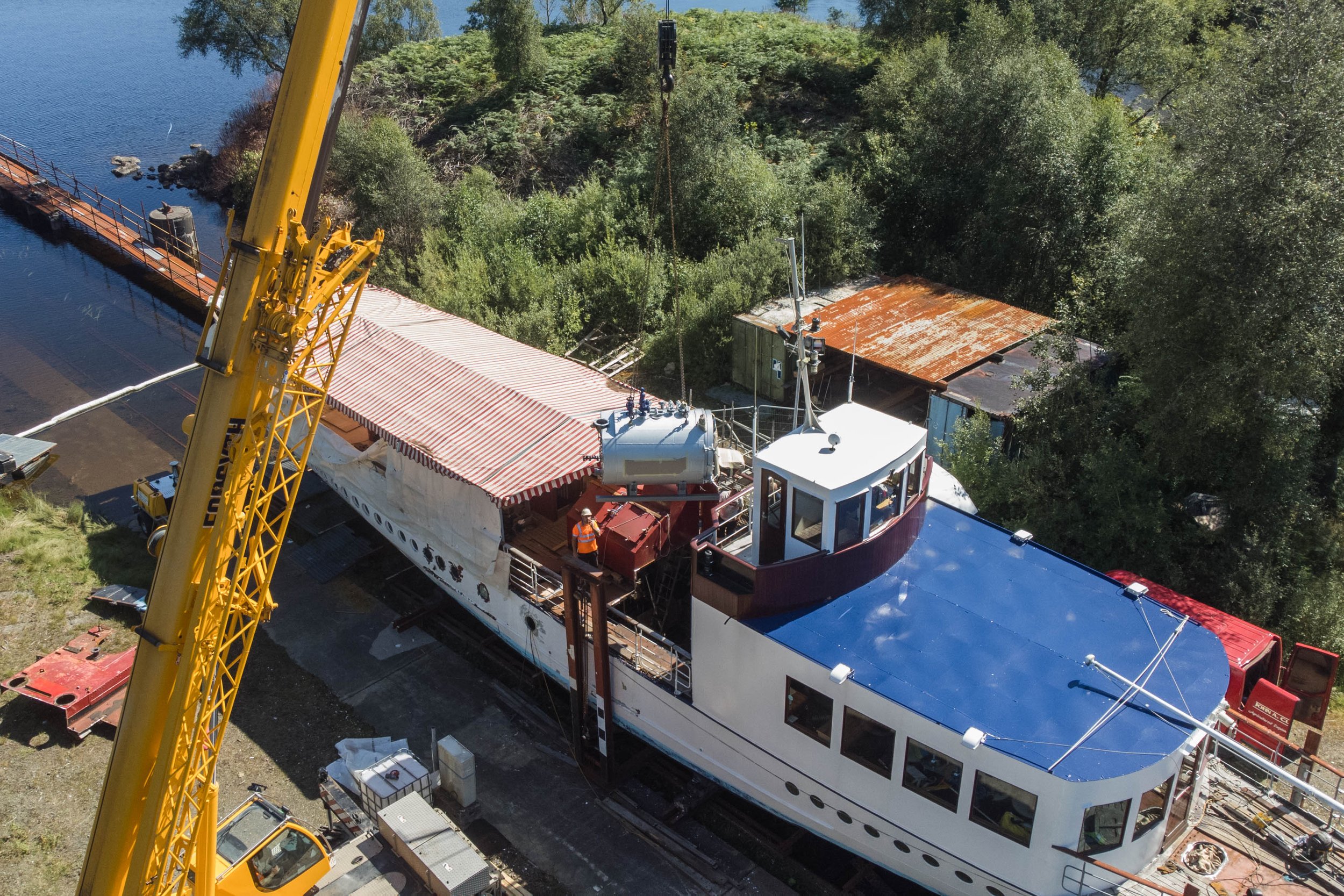
Tourist Era
Picture: Loch Katrine
The Visitors Arrive...
Sometimes it is said that Sir Walter Scott and ‘The Lady of the Lake’, published in 1810, led to the discovery of the Trossachs (It was the view above that inspired Scott to write the poem.) More accurately, his work led to a popularisation of an area that was already receiving attention from people of leisure and taste. By the reign of King George III (1760 onwards) a steady trickle of visitors were penetrating the secret ways and byroads. (The Wordsworths first visit, after all, was seven years ahead of Scott's blockbuster.)
Even the local minister in Callander, the Rev Dr James Robertson, in his contribution to the Statistical Account of Scotland, spends several pages under the heading of 'Romantic Prospects' describing the tourist traffic that was building even before 1790.
He remarks upon what we would call today the 'tourism infrastructure' that locals were putting into place. 'The Hon. Ms Drummond of Perth has erect booths of wicker work, in the most convenient places, for the accommodation of strangers, who visit this wild and picturesque landscape....' He describes the farming tenantry's apparent willingness 'to show the beauties of the place to travellers.'
Exactly the same phenomenon was at the same time taking place in the English Lake District, from about 1760 onwards, and can be seen as a kind of pursuit of the 'Picturesque' as defined by writers such as William Gilpin. The Trossachs became suitable quarry for those who had already 'bagged' England's lakes and mountains!
Victorian Era
In the first half of the 19th century, intrepid visitors to the area found conditions difficult. Thomas Carlyle visited a little inn near Loch Katrine in 1818 and found only 'bad oatcakes and unacceptable whisky' on the menu. In 1838, the judge Lord Cockburn was bemused by the 'altercations,' as tourists bickered over accommodation at another tiny inn. (In the end, they all had to bed down together, numbering around 60, in a space more suitable for a dozen!)
A little over half a century later, towards the end of Victoria’s reign, how different things had become! Not just extended and upgraded old coaching inns, but new hotels had sprung up. For example, one modest hostelry was rebuilt to become the vast and imposing Trossachs Hotel – still a landmark today, though now a time-share business. Loch Katrine got its first steamer, Gypsy, by 1843 – though it was promptly sabotaged: sunk by the crew (probably) of the eight-oared galley Water Witch, who had hitherto had the monopoly on the loch! A replacement steamer, Rob Roy, was on the loch by 1846. Then the Sir Walter Scott came into service in 1900. It is still cruises Loch Katrine today.
Meanwhile, a network of steamer services had developed on Loch Lomond. The latter half of the 19th century also saw the railways expanding to meet the demands of tourism. The Trossachs were encircled – though no lines actually penetrated the very centre. Aberfoyle and Callander had become railheads. The North British Railway stated, immodestly, in a travellers guide in 1914 that the beauty of the area was such that it was ‘the most entrancing single day’s journey in the two hemispheres’.
The journey to which it was referring quickly was already world-famous as ‘The Trossachs Tour’. Inversnaid on the east bank of Loch Lomond had become a busy place. The Wordsworths had landed here in 1803. Thomas Cook took his first tour through by 1850. Here too Gerard Manley Hopkins, after his 1881 visit, wrote his poem with its rallying cry for even 21st-century conservationists ‘Long live the weeds and the wilderness yet’. But by his time, the transportation was coordinated and efficient.
A little over half a century later, towards the end of Victoria’s reign, how different things had become! Not just extended and upgraded old coaching inns, but new hotels had sprung up. For example, one modest hostelry was rebuilt to become the vast and imposing Trossachs Hotel – still a landmark today, though now a time-share business. Loch Katrine got its first steamer, Gypsy, by 1843 – though it was promptly sabotaged: sunk by the crew (probably) of the eight-oared galley Water Witch, who had hitherto had the monopoly on the loch! A replacement steamer, Rob Roy, was on the loch by 1846. Then the Sir Walter Scott came into service in 1900. It is back cruising Loch Katrine after an extensive restoration programme during 2022.
Meanwhile, a network of steamer services had developed on Loch Lomond. The latter half of the 19th century also saw the railways expanding to meet the demands of tourism. The Trossachs were encircled – though no lines actually penetrated the very centre. Aberfoyle and Callander had become railheads. The North British Railway stated, immodestly, in a travellers guide in 1914 that the beauty of the area was such that it was ‘the most entrancing single day’s journey in the two hemispheres’.
The journey to which it was referring quickly was already world-famous as ‘The Trossachs Tour’. Inversnaid on the east bank of Loch Lomond had become a busy place. The Wordsworths had landed here in 1803. Thomas Cook took his first tour through by 1850. Here too Gerard Manley Hopkins, after his 1881 visit, wrote his poem with its rallying cry for even 21st-century conservationists ‘Long live the weeds and the wilderness yet’. But by his time, the transportation was coordinated and efficient.
Streams of visitors embarked at Balloch Pier Station (or got there by tram as that service survived till1928). They sailed up the loch – which had five paddle-steamers operating by the end of the 19th century - and landed at Inversnaid. They took a horse-drawn vehicle up the hill, past the old site of the garrison built to keep Rob Roy in order, along Loch Arklet but, significantly, not along the road to Aberfoyle.
Instead, they re-embarked at Stronachlachar, sailed down Loch Katrine, got back in a four-in-hand at the Trossachs pier, and boarded a train in Callander to return to, probably, Glasgow. Curiously, the coach-and-four connections between Inversnaid and Stronachlachar had the distinction of being the last regular horse-drawn public transport service when replaced by buses for the 1938 season! This was the classic Trossachs Tour – also done in reverse from Callander.
There were also variations – from Aberfoyle by way of the Dukes’ Pass to the Trossachs by coach, followed by the departure from the Trossachs Pier. This road (sometimes also called The Duke’s Road) was completed by the Duke of Montrose in 1882, around the same time as the railway arrived in Aberfoyle. It was a private toll road till it was upgraded and freed from tolls in the 1930s.
Visitors could, for example, also take the steamer up the loch to Tarbet, then return via steamer (or rail) from Arrochar – as the Clyde sea lochs were also interconnected by these regular passenger and mail-carrying steamer services.
Unavoidably, as the 20th century progressed, the ubiquitous motor car changed the pattern of how visitors flowed through the area. For example, the Rest and Be Thankful, that famous watershed, and gateway to today’s Argyll Forest Park, was reached by the military road-builders by 1748, and handed over to civic authorities by 1814 for maintenance. Johnson and Boswell, Thomas Pennant, the Wordsworths and even the delicate John Keats (see panel) all went over the high pass. But not until the late 1930s was the ‘new’ road built, cut into the slopes above the original way.
In the period just before WWII, another phenomenon had impacted on the park. The 1930s in particular were notable for an enthusiasm for ‘fresh air and exercise’ and cycling and walking clubs were especially popular. It was the age of the hiker and hosteller. At the same time, the industrial depression afflicting the Clydeside towns meant that many could barely afford to take public transport further than Arrochar and Tarbet station on the West Highland Line. After a weekend climbing in the ‘Arrochar Alps’ (the name invented by Dumbarton-born author and climber Ben Humble), the outdoor enthusiasts made their way south. Just before the war the LNER even ran a special Sunday evening train for the befit of homeward bound climbers.
As for railways, Callander and Aberfoyle are now without rail connections – though the West Highland Line continues to offer those peerless views of the sea-lochs and Ben Lomond. The Maid of the Loch, originally built by British Railways in 1953, and the last of the Loch Lomond steamers, ran her last season in 198, though hopes are high that she may sail again. (She is currently a static exhibit at Balloch.)
However, Loch Katrine still has its cruises. And Loch Lomond has a burgeoning water bus service in addition to a wide range of loch cruising vessels departing from the loch-side communities. And there are no more private lands and access issues with recalcitrant land-owners of the kind that sometimes faced early travellers. Instead, a network of waymarked walking and cycle routes open up the landscape for all. Perhaps the most famous of these is the West Highland Way, opened in 1980, and running down the east side of Loch Lomond. Today, thanks to the water bus service, it is possible to walk a length of the way, for example, Inversnaid to Rowardennan, using the ferry connections to return to depart and return to, for example, Tarbet.
Today’s outdoor enthusiasts are the inheritors of the area’s great outdoor traditions, not just on the hills but also on the water. In the 1920s, messing about in boats could mean building your own houseboat from a converted ship’s lifeboat. Today, the slipways and mooring places are even busier with craft that are mostly much more sophisticated.
Ashore and afloat, the Loch Lomond and Trossachs National Park, from Breadalbane to the sea lochs of the west, is Scotland’s most popular outdoor destination, with 4 million visitors every year. Managing these numbers, so that the area preserves the very qualities of wildness and beauty that attracted visitors in the first place, was the motivation for discussions on the way forward for the area, as far back as the late 1940s. This was when the proposal for a National Park was first made. That goal was reached in 2002. Now, a sustainable future for the Park still remains the priority for both the Park Authorities and The Friends of Loch Lomond and the Trossachs.
John Keats’ walking tour
In 1818, Keats and a friend were on a walking tour. They had heard the name ‘Rest and Be Thankful’ and assumed that it referred to some kind of inn at the top of the pass. After a very early start they were looking forward to breakfast. Keats’ diary entry states: “We were up at four this morning and have walked to breakfast 15 miles through two tremendous Glens – at the end of the first there was a place called rest and be thankful which we took for an inn – it was nothing but a stone and so we were cheated into five more miles to breakfast”. Tourist information had a long way to go in those early days!


